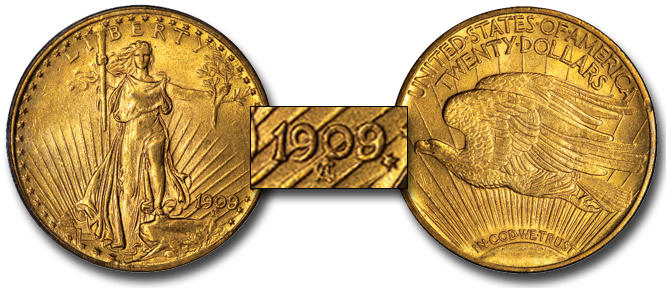
Answer: The 1909/8 is the only overdate in the Saint-Gaudens double eagle series. I estimate that it constituted about 40% of the 161,282 mintage for the 1909 date. It has been suggested that the overdate is even more plentiful than the regular date; the evidence seems inconclusive, but leans to the contrary. It is likely that many 1909/8 coins remained in the United States and were melted in the 1930s.
Of the Mint State pieces that exist today, most grade from MS-60 to MS-63, but enough MS-64 pieces exist that a specialist can locate one without intense effort. Higher-grade Gem coins are considerably scarcer, in fact, quite rare. In circulated grades, typically EF and AU, I suggest a population of 3,500 to 5,000 or a bit more.
The story of the 1909/8 is interesting in that until after 1970 the overdate was considered to be quite scarce, even rare, and the typical example was apt to be AU or a very low level Mint State. The writer recalls looking through quantities of double eagles in the 1960s and not finding any Mint State specimens. In later times specimens in higher grades gradually came onto the market, so that by 1982 when David W. Akers wrote his text on double eagles, high-grade specimens were no longer numismatic curiosities.
A little bit of numismatic history:
The May-June 1910 issue of The Numismatist included this item by Edgar H. Adams:
“Overstruck dates are those where the die of one year has been altered to do service for the succeeding one. The last figure in the date is usually gouged out and replaced by the new one, but seldom is this operation conducted so skillfully that traces of it are not left. Of course the reason for this is to save money in the making of the dies, and the practice has by no means been abandoned altogether, for careful scrutiny of the Saint-Gaudens $20 piece of 1909 will reveal traces of what seems to have been the alteration of the figure 8 to 9.”
Today we know that the master die contained the full date 1908 or 1909 as the case may be. The most likely scenario is that an already made 1908 working die was impressed by a 1909 master die, neatly creating the overdate. There was no “gouging” or alteration of the date figures; one simply appeared above the other.
At the time, Adams was in the forefront of numismatic research. However, as sometimes happens, Adams 1910 article on the 1909/8 double eagle seems to have been forgotten. In 1941 Abe Kosoff included examples of the issue in two of his sales, but no special notice was taken of them.
In the May-June 1943 issue of The Coin Collector’s Journal Abe Kosoff discussed the 1909/8 double eagle, “of which five copies have been discovered,” and an illustration of the variety was printed. After this notice, demand for the overdate multiplied. In 1944, the 1909/8 was added to Wayte Raymond’s Standard Catalogue of United States Coins, the standard reference at the time. Beginning in 1945 the overdate was added to Whitman’s Handbook of United States Coins. When A Guide Book of United States Coins was first published in 1946 (cover date 1947) the variety was listed.
Years later overdates became a more important part of numismatics, and stocks of double eagles, particularly in overseas banks, would be searched to reveal countless hundreds of examples of the 1909/8 variety.





